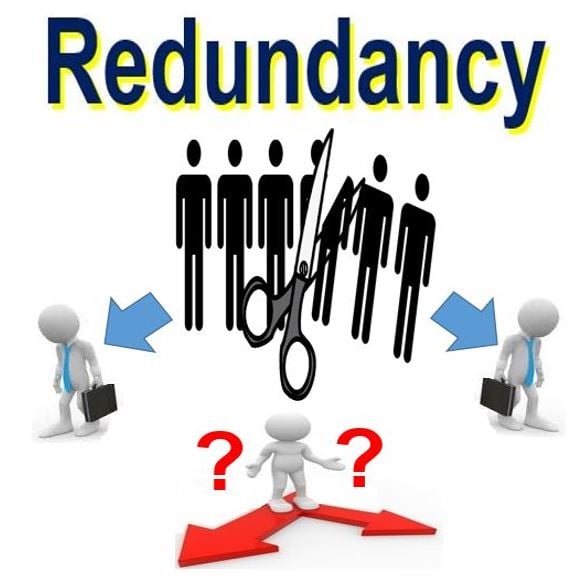Your Rights to Redundancy If Company Goes Bust: UK Employee Protections
Your Rights to Redundancy If Company Goes Bust: UK Employee Protections
Blog Article
Checking Out the Operational Dynamics of Business Redundancy and Its Long-Term Sustainability

Redundancy Strategies for Service Continuity
In order to ensure nonstop operations, businesses have to execute efficient redundancy strategies for company connection. Redundancy in this context describes the duplication of important parts or functions within a system to mitigate the effect of possible failings. By incorporating redundancy strategies, companies can boost their strength versus disruptions brought on by different aspects such as natural calamities, devices failings, or cyber-attacks.
One typical redundancy approach is the execution of back-up systems and data storage options. This entails producing matches of important data and systems that can be triggered in situation of a key system failing. In addition, companies can develop repetitive communication channels and source of power to maintain connection and procedures during unexpected events.
Furthermore, cross-training workers to carry out several functions within the business can act as a useful redundancy approach. This ensures that important tasks can still be carried out even if key employees are not available as a result of ailment or other factors. Overall, reliable redundancy strategies are vital for businesses to promote functional continuity and minimize the effect of possible interruptions.
Influence of Redundancy on Organizational Resilience
Offered the vital duty redundancy strategies play in making certain business continuity, checking out the effect of redundancy on business resilience becomes necessary for recognizing the alternative functional characteristics of a firm. Redundancy, when purposefully applied, can considerably contribute to improving a company's durability in the face of unexpected challenges.
Furthermore, redundancy can cultivate technology and imagination within an organization as employees feel empowered to take computed dangers, knowing that there is a safety and security internet to sustain them in situation of failing. On the whole, the impact of redundancy on business strength is profound, forming the long-lasting sustainability and success of a company.
Balancing Performance and Versatility in Redundancy
Achieving an unified stability between functional effectiveness and flexible adaptability is a crucial difficulty in the strategic implementation of redundancy within organizations. Reliable operations are vital for maintaining efficiency and cost-effectiveness, ensuring that sources are used optimally. Nevertheless, too much emphasis on effectiveness alone can result in strength, making it challenging for companies to adjust to unforeseen modifications or obstacles. On the other hand, versatility permits organizations to respond nimbly to advancing situations, promoting technology and resilience. Yet, way too much flexibility without a strong operational foundation can lead to inadequacies and disparity.
To stabilize efficiency and adaptability in redundancy preparation, organizations should carefully assess their functional requirements, market dynamics, and critical goals. Inevitably, discovering the best stability between effectiveness and versatility is important for building a resilient and lasting company in the face of uncertainty.
Long-Term Sustainability Via Redundancy Preparation
To make certain enduring practicality and stability, organizations have to purposefully straighten their redundancy planning with long-term sustainability goals, thereby harmonizing functional efficiency with flexible adaptability. Business must check out redundancy not as a reactive solution to immediate problems but as a proactive strategy for long-term success.

Aggressive Steps for Lasting Firm Operations
How can firms proactively enhance their operational sustainability for long-lasting success? Applying proactive procedures is vital for firms intending to ensure sustainable operations. One key technique is to buy innovation and technology to simplify procedures, reduce waste, and stay competitive on the market. Embracing lasting practices such as decreasing energy usage, reducing carbon footprint, and optimizing this website source application can not just profit the setting yet additionally bring about set you back financial savings over time.
In addition, cultivating a culture of continuous improvement and understanding within the organization can enhance adaptability to transforming market problems and customer needs. Motivating worker involvement in decision-making procedures and supplying opportunities for expert advancement my site can boost spirits, efficiency, and total efficiency. Developing clear objectives, checking key efficiency indicators, and consistently examining development are vital elements of aggressive sustainability monitoring.
Working together with vendors, consumers, and other stakeholders to advertise sustainable practices throughout the supply chain can produce a causal sequence of favorable influence - redundancy pay if company goes bust. By taking aggressive actions in the direction of functional sustainability, firms can construct durability, drive technology, and protect their long-term success in an ever-evolving business landscape
Verdict

In the realm of business administration, the tactical implementation of firm redundancy stands as an essential yet complex practice that necessitates a fragile equilibrium between functional performance and lasting viability. By studying the operational characteristics that underpin firm redundancy and reviewing its broader ramifications why not try these out for organizational resilience and adaptability, a nuanced understanding of how redundancy approaches can shape the future trajectory of a firm starts to unfold.Given the important duty redundancy methods play in ensuring organization connection, discovering the impact of redundancy on organizational resilience becomes imperative for comprehending the all natural functional dynamics of a firm. Overall, the impact of redundancy on business durability is profound, forming the long-lasting sustainability and success of a firm.
In conclusion, comprehending the operational characteristics of business redundancy is critical for making sure lasting sustainability.
Report this page